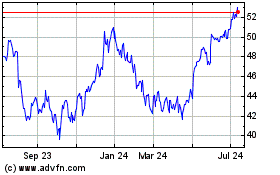Health-Care REITs Back Off Nursing
October 11 2016 - 1:23PM
Dow Jones News
By Esther Fung
Senior housing, medical-office buildings and hospitals all have
generated big gains for commercial-real-estate investors in recent
years, but skilled-nursing facilities have gotten short shrift.
A revenue squeeze stemming from a change in medical billing
practices suggests that corner of the health-care sector could
continue to face pressure.
The problem: Payments from Medicare and other government
insurance programs make up the bulk of the revenue at skilled
nursing facilities. Landlords say their tenants are battling with
shorter lengths of stay and lower rates as billing practices focus
more on the value of care delivered than earlier models based on
the volume of services the facility provided. Now, some big
real-estate investment trusts that focus on health care are
starting to pare their skilled-nursing holdings.
Chicago-based Ventas Inc. in August 2015 spun off 355 skilled
nursing facilities and outpatient recovery centers into a new REIT.
Irvine, Calif.-based HCP Inc. is carrying out its own separation,
while Sabra Health Care REIT Inc. is trimming its exposure and is
now in the process of selling 29 of these assets.
"It's a turning point for health-care REITs," said Britton
Costa, director in Fitch Ratings' U.S. REITs group.
For REITs, heavy exposure to skilled-nursing operators that
might face pressure in their ability to pay rent adds a layer of
risk that, in turn, makes it costlier for them to raise funds.
Medical office buildings and hospitals, which have steadier income
and more control over billings, are seen as better bets.
"The spinoff will improve our portfolio quality...and reinforce
the stability and growth profile of our cash flow," said Mike
McKee, executive chairman of HCP in June when the company announced
the spinoff of its HCR ManorCare portfolio of skilled nursing and
assisted-living assets. ManorCare has been struggling with
operational missteps and headwinds from reimbursement changes.
After its 2015 spinoff, Ventas enjoyed stronger growth and
achieved a greater portion of its net income from so-called
private-pay assets, said Chief Executive Officer Debra Cafaro.
Private-pay assets largely serve those who pay out of pocket or
have coverage from commercial insurers rather than the
government.
Some investors have been more hesitant about parking money in
health-care REITs that contain skilled-nursing facilities, because
landlords face the risk of their tenants struggling with rent
payments if government budgets tighten.
But real-estate investors and analysts also say it is unlikely
the market would see a resurgence of bankruptcies among these
facilities that occurred in the late 1990s, when the operators then
were more highly leveraged.
"It's not going to be as bad as what's perceived out there, but
it's going to be bumpy for a while," said Jerry Ehlinger, managing
director at Heitman, a real-estate investment-management firm,
which has been underweight on health-care REITs for the past five
years. It has $250 million invested in health-care REITs, which
account for about 12% of its U.S. REIT investments.
"Health-care REITs had been on an enormous pie-eating contest
for market share six, seven years ago. These billion-dollar deals
have to come to an end," Mr. Ehlinger said.
To be sure, there is still potential for growth in REITs
specializing in skilled-nursing centers, given rising demand from
aging demographics and their position as a cheaper alternative to
prolonged hospital stays. Investors now pay twice as much to invest
in skilled nursing facilities as they did a decade ago. Last year,
the average price of a bed in a skilled nursing property priced
above $1 million was $78.28, double the $37.74 recorded in 2005,
according to data from commercial-real-estate firm Marcus &
Millichap. The numbers aren't adjusted for inflation.
Omega Healthcare Investors Inc., the largest REIT focused solely
on skilled nursing properties, saw its net income nearly double in
the first half this year compared with the same period last year,
mainly from acquisitions and other investments. Its share price is
down around 7% over the past year.
"Most of our tenants are experiencing modest earning pressure as
a result of CMS's [Centers for Medicare & Medicaid Services']
continued push towards episodic payment systems," but lease
payments aren't affected, said Omega spokesman Thomas H. Peterson.
The Centers for Medicare & Medicaid Services' has been moving
away from a fee-for-service payment model for years now, but the
vast majority of Omega's tenants have cash flow that exceeds their
rent obligations, he said.
Write to Esther Fung at esther.fung@wsj.com
(END) Dow Jones Newswires
October 11, 2016 13:08 ET (17:08 GMT)
Copyright (c) 2016 Dow Jones & Company, Inc.
Ventas (NYSE:VTR)
Historical Stock Chart
From Mar 2024 to Apr 2024

Ventas (NYSE:VTR)
Historical Stock Chart
From Apr 2023 to Apr 2024
